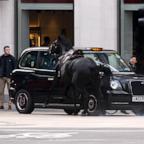Breath easy: NASA finds no 'imminent risk' from asteroids
CAPE CANAVERAL, Fla. -- Armageddon is not imminent.
Bruce Willis, Ben Affleck and Billy Bob Thornton can stand down. There is no apocalyptic asteroid barreling toward a catastrophic collision with Earth. No inbound planet-killer for at least the next few centuries. No need for NASA to scramble a team of blue-collar, deep-core drillers to save the world.
A new NASA census spotted 93% of all supersized space rocks zipping through near-Earth orbits. NASA scientists said Thursday that none of the 981 detected represent a hazard of Hollywood proportions.
"We know that there are none that pose any imminent risk of an impact," said Amy Mainzer of NASA's Jet Propulsion Laboratory in Pasadena, Calif. "Planet X is not coming to get us."
NASA's Wide-Field Infrared Survey Explorer spent the past two years scanning the skies with a 16-inch telescope and four infrared detectors 100 times more sensitive than those on predecessor spacecraft.
The robotic sentinel detected hundreds of thousands of asteroids in a main belt between Mars and Jupiter, and it also surveyed those flying in orbits closer to Earth. Tracking space rocks closer to the planet is critical to avoiding the type of cataclysmic impact that wiped out the dinosaurs 65 million years ago.
"The best three ways of of dealing with the potential of an asteroid impact are to find them early, find them early, and find them early," said Mainzer, the principal investigator with the WISE project.
The sooner a threat is detected, the sooner it can be dealt with and the less energy would be needed to nudge an incoming space rock off course, she said.
Congress in the late 1990s was concerned enough with the potential for asteroid collisions that it ordered NASA to search for all in the vacinity of Earth's orbit. Not so coincidentally, the call came at about the same time that the Hollywood asteroid disaster films Armageddon and Deep Impact opened in theaters around the country.
The census taken by the WISE spacecraft found far fewer mid-sized asteroids — those between 330 feet and 3,300 feet in diameter — than previously estimated: 19,500 rather than 35,000, or about 40% fewer.
There was only a small decline in the number of the largest near-Earth asteroids detected: those the size of a small mountain, more than a half-mile in diameter. Asteroids that large would have global consequences if they crashed into Earth.
"We find that there are fewer near-Earth asteroids out there. However, it is important to note that fewer does not mean none," Mainzer said.
The WISE spacecraft detected 981. Previous estimate: about 1,000. Mainzer said the new number represents 93% of the estimated total poplation of large near-Earth asteroids. The percentage meets a goal established by Congress in 1998, and none of the big asteroids will be a threat to Earth in the next few centuries.
"We know where they are and by virtue of the fact that we know these objects, and we know their orbits, we can predict that they are no longer hazardous to Earth," Mainzer said.
The $320 million WISE mission also will contribute to NASA's plan to meet President Barack Obama's call for a human expedition to an asteroid by 2025. The new census will yield a list of the most likely asteroids to target for a visit.
"We're working with the human spaceflight folks in examining the known population of near-Earth asteroids to determine if there are available targets," said Lindley Johnson, NASA's Near-Earth Object program executive.
"Those that have the closest encounters with Earth — those are the objects that will make the best human space flight targets."




